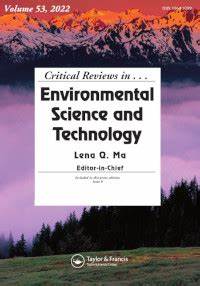非热等离子体高级氧化还原工艺中微污染物降解的活性物质:产生、贡献和利用
IF 13.2
1区 环境科学与生态学
Q1 ENVIRONMENTAL SCIENCES
Critical Reviews in Environmental Science and Technology
Pub Date : 2025-06-03
DOI:10.1080/10643389.2025.2511673
引用次数: 0
摘要
非热等离子体废水处理技术结合了高级氧化工艺(AOPs)和高级还原工艺(ARPs)的优点,在微污染物污染废水的治理中得到了越来越多的关注。这篇综述文章汇编和组织了过去几年关于非热等离子体技术在废水处理中的应用的同行评议的科学出版物。特别侧重于深入讨论(i)放电等离子体产生的氧化和还原性物质的过程,(ii)反应性物质在各种微污染物降解中的作用,以及(iii)通过扩大技术规模并将等离子体与包括催化在内的其他方法相结合来改善微污染物降解的可能性。分析表明,提高反应物质利用率主要有两种途径:(1)提高反应物质的传质;(2)提高具有强氧化还原电位的反应物质(如•OH和eaq -)的生成。最大限度地利用反应物质可以降低非热等离子体技术的能耗,促进其工业化应用。本文对等离子体降解微污染物技术中活性物质的产生、贡献和利用进行了全面的探讨,重点介绍了非热等离子体在工业应用中的可扩展性,解决了现有文献中的空白。本文章由计算机程序翻译,如有差异,请以英文原文为准。
Reactive species in nonthermal plasma-based advanced oxidation and reduction processes for micropollutants degradation: Generation, contribution and utilization
Nonthermal plasma wastewater treatment technology, which combines the advantages of advanced oxidation processes (AOPs) and advanced reduction processes (ARPs), has attracted increasing attention for remediating micropollutant-contaminated wastewater over the past few decades. This review article compiles and organizes peer-reviewed scientific publications from the last several years on the application of nonthermal plasma technologies for (waste)water treatment. Special focus is put on an in-depth discussion of (i) the processes of oxidative and reductive species generated by discharge plasma, (ii) the role of reactive species in various micropollutants degradation, and (iii) the possibilities to improve the degradation of micropollutants by scale up the technology and combining plasma with other methods, including catalysis. The analysis reveals that enhancing the utilization of reactive species can be achieved through two main approaches: (i) enhancing the mass transfer of reactive species, and (ii) improving the generation of reactive species with strong redox potential (such as •OH and eaq–). The maximum utilization of reactive species can reduce the energy consumption of nonthermal plasma technology and promote its industrial application. This review offers a comprehensive exploration of the generation, contribution and utilization of reactive species in plasma technology for micropollutant degradation, addressing gaps in existing literature by focusing on the scalability of nonthermal plasma in industrial applications.
求助全文
通过发布文献求助,成功后即可免费获取论文全文。
去求助
来源期刊
CiteScore
27.30
自引率
1.60%
发文量
64
审稿时长
2 months
期刊介绍:
Two of the most pressing global challenges of our era involve understanding and addressing the multitude of environmental problems we face. In order to tackle them effectively, it is essential to devise logical strategies and methods for their control. Critical Reviews in Environmental Science and Technology serves as a valuable international platform for the comprehensive assessment of current knowledge across a wide range of environmental science topics.
Environmental science is a field that encompasses the intricate and fluid interactions between various scientific disciplines. These include earth and agricultural sciences, chemistry, biology, medicine, and engineering. Furthermore, new disciplines such as environmental toxicology and risk assessment have emerged in response to the increasing complexity of environmental challenges.
The purpose of Critical Reviews in Environmental Science and Technology is to provide a space for critical analysis and evaluation of existing knowledge in environmental science. By doing so, it encourages the advancement of our understanding and the development of effective solutions. This journal plays a crucial role in fostering international cooperation and collaboration in addressing the pressing environmental issues of our time.

 求助内容:
求助内容: 应助结果提醒方式:
应助结果提醒方式:


